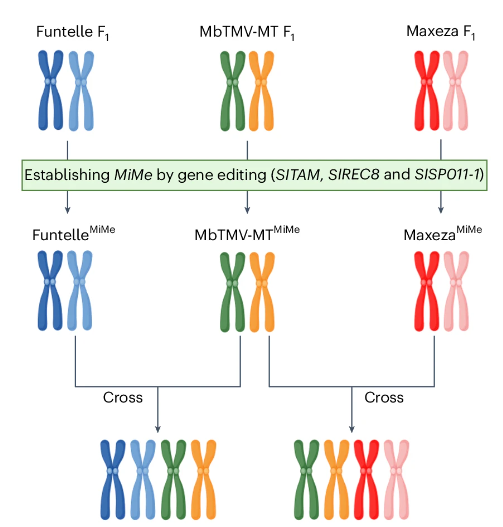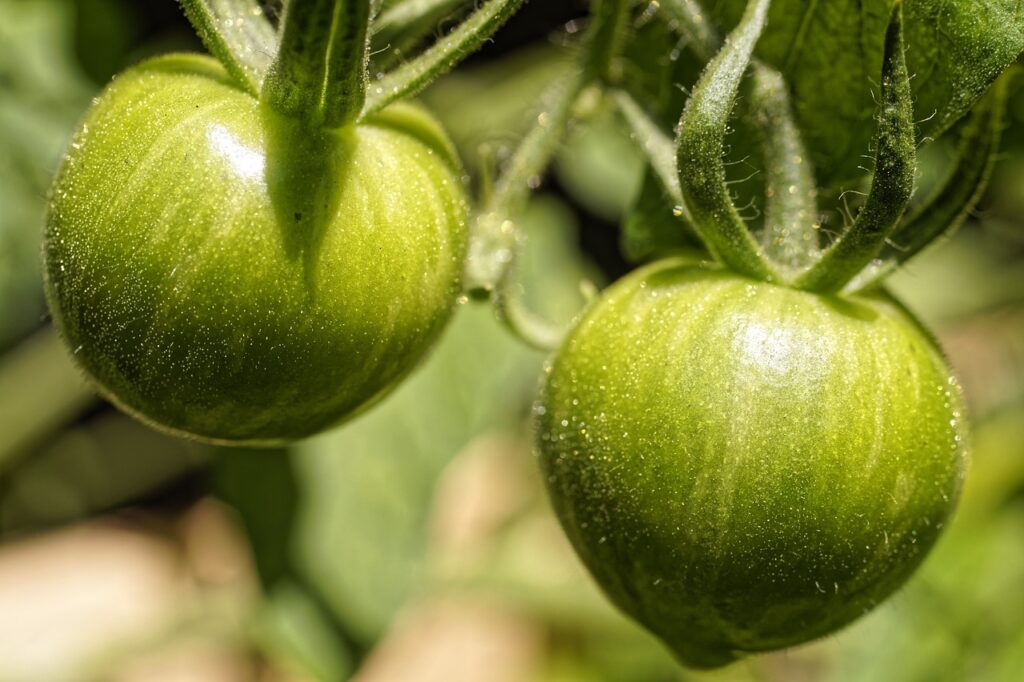The Barrier of Cross Breeding
The vegetables and grains we usually eat are the fruits of breeding that has continued since ancient times. Pinpoint breeding through genome editing has also become possible, but most of the crops we benefit from are produced through “cross breeding”. In cross breeding, parents with useful traits beneficial to humanity are crossed to create the next generation with both useful traits. I believe that the majority of varieties will still be created through cross breeding in the future.
While many useful varieties have been created using cross breeding methods, there are also challenges. For example, the pollen and egg cells that form the basis of the next generation undergo “meiosis”, passing only half of the parent’s traits to the next generation. Therefore, the probability that the desired useful traits of the parents will be passed to the next generation is 1/2 from the pollen parent and 1/2 from the egg cell parent, resulting in only 1/4 of the seeds carrying the desired traits. In actual breeding, it is not just one or two traits that we want to pass on to the next generation, but many traits. The more traits we want to pass on, the more seeds we need to obtain, and we cannot always get individuals with the desired traits. The crops we currently consume have overcome these difficulties, and we can say that enormous costs are involved. Further useful varieties are needed to combat hunger and improve production efficiency, but seeking even more useful traits will require even greater costs and some kind of breakthrough.
The Potential of Polyploids
One means of solving these problems is the utilization of “polyploids”. There are already examples of breeding using polyploids, such as “seedless watermelons”, but their potential is still unknown. Polyploids are individuals with double the number of genes compared to their parents. These individuals inherit all the parent’s traits without losing any due to cross breeding. This is the same for both pollen and seed parents. As an image, in normal cross breeding, pollen and seed parents originally have a gene amount of “2”, but this decreases to “1” when creating pollen or egg cells. The pollen and egg cells, both having “1”, fuse to create the next generation with a gene amount of “2”, the same as the parents. In contrast, in polyploids, pollen or egg cells do not decrease to “1”, but remain “2”. As a result, when pollen and egg cells fuse, the next generation with a gene amount of “4” is created. Naturally, polyploids inherit all traits from the parents, without leaving out any traits. By effectively utilizing these polyploids, individuals with good traits or those that grow large can be created.

「Mitosis instead of meiosis (MiMe) system」
Although breeding using polyploids, which seems to be all beneficial, can only be applied to limited species, and only a few results have been made public. If more varieties can be applied, it might bring about a revolution. The catalyst for this could be the “Mitosis instead of meiosis (MiMe) system”. When pollen or egg cells are created, “meiosis” occurs, reducing the gene amount by half, but the MiMe system goes through the same division process (mitosis) as normal cell division instead of meiosis. This results in the creation of pollen and egg cells that do not reduce to “1”, but remain “2”. Until now, such phenomena had been confirmed only in some species, but recently, important genes for the MiMe system have begun to be identified. For example, in tomatoes, it has been found that the MiMe system can be utilized by knocking out three genes: “SlSPO11-1”, “SlREC8”, and “SlTAM”. The prefix “Sl” stands for Solanum lycopersicum, the scientific name for tomatoes, meaning SPO11-1, REC8, and TAM in tomatoes. Therefore, if similar genes in other plants can be identified and knocked out, it might be possible to reproduce the MiMe system, potentially opening up new areas in cross breeding.
参考文献:https://www.nature.com/articles/s41588-024-01750-6

The Potential and Challenges of Addition Breeding
Using the MiMe system introduced this time, it might be possible to quickly create useful varieties by crossing parents with useful traits in various species to create polyploids. Additionally, it might be possible to create new breeding parents by polyploidizing species where polyploids have not been confirmed before. The possibilities are endless!
While I have described many positive aspects, various disadvantages of polyploid breeding have already been pointed out and need to be overcome. For example, when creating polyploids, the fruits might become smaller instead of larger, showing polyploid-specific reactions that need to be tested for each species. As the number of useful traits that can be accumulated increases, breeding must consider traits not only from the parents but also from several generations back. Furthermore, traits are not determined solely by inherited genes; in reality, they are inherited in various forms, such as cytoplasmic inheritance (cytoplasmic factors), showing combined reactions. This makes breeding strategies complex.
There are also business challenges. Modern seed businesses have succeeded by utilizing F1 seeds. F1 seeds are seeds with accumulated useful traits, but the seeds obtained in the next generation do not all have the same traits as the parents, so farmers need to continue buying F1 seeds to maintain yield. In breeding using polyploids, business development using F1 seeds is difficult to adapt, requiring new business schemes.
While I have written about various merits and demerits, this shows that polyploids are an unknown field with great potential. In the future, breeding using polyploids may increase, and the frequency of polyploid-derived crops on our tables may increase.




コメント